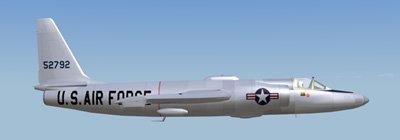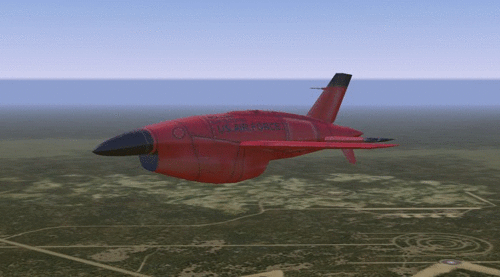The Shooting Star was the first USAF aircraft to exceed 500 mph in level flight, the first American jet airplane to be manufactured in large quantities and the first USAF jet to be used in combat. Designed in 1943, the XP-80 made its maiden flight on Jan. 8, 1944. Several early P-80s were sent to Europe for demonstration, but WW II ended before the aircraft could be employed in combat. (The aircraft was redesignated in 1948 when "P" for "Pursuit" was changed to "F" for "Fighter.") Of 1,731 F-80s built, 798 were F-80Cs.
Although it was designed as a high-altitude interceptor, the F-80C was used extensively as a fighter-bomber in the Korean Conflict, primarily for low-level rocket, bomb and napalm attacks against ground targets.
The most famous spy-plane of the Cold War era was a product of the Lockheed Skunk Works. The U-2 was designed to fly at altitudes that put it beyond the reach of interceptors. The advent of surface-to-air missiles brought U-2 over flights of the Soviet Union to halt in 1960 after an aircraft flown by Gary Powers was downed by an SA-2.
As per a request from Buff, this is a .rar of Pasko's F-82 from my Korean War aircraft folder. It contains his original readme, and weapons zip, which (the weapons zip) you probably don't need to use if you have the latest weapons pack working. I have not been able to contact Pasko to get his permission to upload this, so if he sees it and wants it down, down it comes. All I did was squeeze it into a .rar. It is solely the work of Pasko, Gramps, Starfighter, and Wolf257, the people mentioned in the readme. It is their work. I am uploading this solely as a favor to people I consider friends, because we all miss Pasko's site and his wonderful work, but if Pasko, Gramps, Starfighter, or Wolf257 have a problem with this upload, then it will go the way of my last wingman, and disappear into a smoking hole in the ground. Enjoy.
BQM-34 target drone made by RussoUK2002 for use with Strike Fighters: Project 1.
One of the most heavily armed fighter aircraft, the F-89 was the backbone of
the North American Air Defense Command for more than 17 years.
The F-89 was the first multi-seat, all-weather jet interceptor. It was the first
aircraft designed to carry an all-rocket armament and the first to carry the Hughes Falcon
air-to-air guided missile.Northrop was awarded a contract May 3, 1946, to build two
prototypes designated XP-89. The XP-89 rolled out of its California plant in the summer of 1948.
The F9F-5P was the mainstay of US Navy Photo-Reconnaissance squadrons in the mid-1950s, eventually being replaced by the swept-wing Cougar.
The Grumman F9F Panther was the first truly successful jet fighter to enter US Navy service. It formed the backbone of carrier air wings from the late 1940s to the mid 1950s.
The two-place T-33 jet was designed for training pilots already qualified to fly propeller-driven aircraft. It was developed from the single-seat F-80 fighter by lengthening the fuselage slightly more than three feet to accommodate a second cockpit.
Originally designed the TF-80C, the T-33 made its first flight in March 1948. Production continued until August 1959 with 5,691 T-33s built. In addition to its use as a trainer, the T-33 has been used for such tasks as drone director and target towing, and in some countries even as a combat aircraft. The RT-33A version, reconnaissance aircraft produced primarily for use by foreign countries, had a camera installed in the nose and additional equipment in the rear cockpit.






